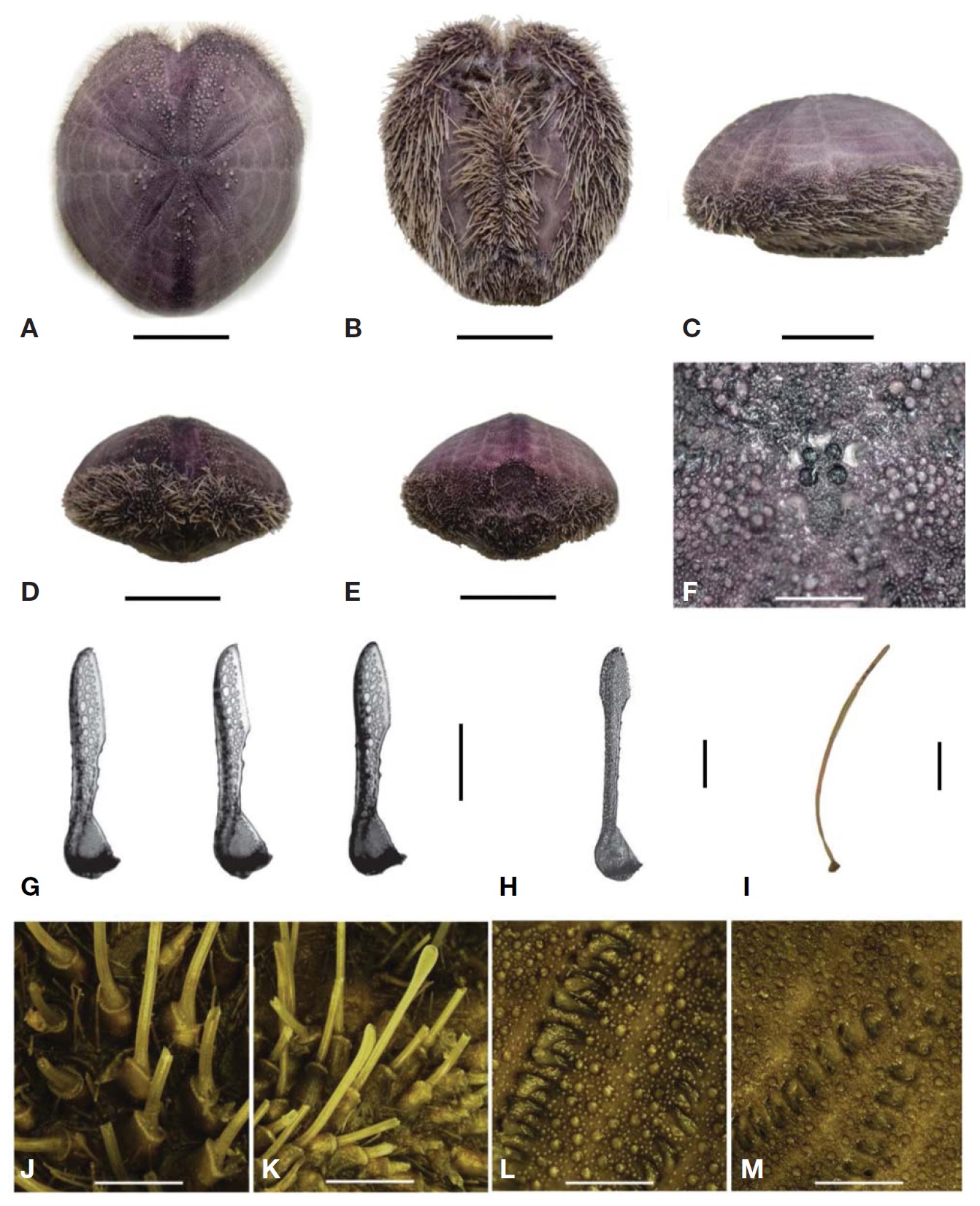



Sea urchins which are obviously bilaterally symmetrical, have an anterior mouth and are informally termed “heart urchins” are organized into the order Spatangoida representing one of the most easily recognizable groups within the class Echinoidea (Smith, 2004). This order is the most diverse one of all the extant orders of sea urchin (Stockley et al., 2005). They are found in all the major oceans of the world, and vary in their geographical distribution from highly localized to highly cosmopolitan. Family Spatangidae of order Spatangoida comprises 15 species within two genera in the world (Kroh and Mooi, 2013). In this study the genus
The specimen was collected from Geomundo Island on July 3, 2009 and was preserved in 95% ethyl alcohol. The important morphological characters were photographed by a digital camera (Nikon D7000; Nikon Co., Tokyo, Japan), light- and stereo-microscopes (Nikon Eclipse 80
Class Echinoidea Leske, 1778
Subclass Euechinoidea Bronn, 1860
Order Spatangoida L. Agassiz, 1840
Suborder Brissidina Stockley, Smith, Littlewood, Lessios & MacKenzie-Dodds, 2005
Key to the families of suborder Brissidina in Korea
1. Internal fasciole present ?????????????????????????????? Loveniidae
- Internal fasciole absent ????????????????????????????????????????????? 2
2. Peripetalous fasciole present ?????????????????????????? Brissidae
- Peripetalous fasciole absent ??????????????????????????????????????? 3
3. Sternal system completely covered with tubercles ??????????????????????????????????????????????????????????????????????????? Spatangidae
- Sternal system not completely covered with tubercles ??????????????????????????????????????????????????????????????????????? Maretiidae
Family Spatangidae Gray, 1825
Test heart shaped, oval outline. Apical system ethmolytic. Subanal fasciole present, but no other fascioles. Petals well developed. Ventral part of poriferous zones usually rudimentary.
Type genus:
Genera 3 (1 in Korea).
1*Genus Spatangus Gray, 1825
Spatagus OF Muller, 1776: 236.
Spatangus Gray, 1825: 527; L Agassiz and Desor, 1847: 6; HL Clark, 1917: 233; 1925: 224; Mortensen, 1951: 7; Nisiyama, 1968: 199; Rowe and Gates, 1995: 244; Kroh and Mooi, 2013: 123430.
Prospatangus Lambert, 1902: 55; 1915: 192; Lambert and Thiery, 1924: 459.
Test rigid, broad oval outline, with a fairly deep frontal ambulacral groove. Paired ambulacra form very distinct petals, nearly closed distally, not sunken. Apical system subcentral, with four genital pores, ethmolytic. Labrum prominent. Sternum generally narrow. Periproct on truncated posterior end.
Type species:
Species 14 (1 in Korea).
2*Spatangus luetkeni A. Agassiz, 1872 (Fig. 1)
Spatangus luetkeni A Agassiz, 1872: 57; 1873: 564; HL Clark, 1917: 238, Pl. 146, fig. 17, pl. 157, figs. 5, 6; Mortensen, 1951: 18; Rowe and Gates, 1995: 245; Kroh and Mooi, 2013: 513548.
Material examined. 1 specimen by Hyun Sik Lim, Geomundo Island, 3 July 2009.
Description. Test medium-sized, thick, strong, oval outline, regularly indented anterior, with a fairly deep broad frontal ambulacral groove, with dorsal side regularly arched both transversely and longitudinally, ventral side flat, truncated at posterior end. Apical system with four genital pores, subcentral, lying anterior, vertex slightly posterior. Madreporite extending beyond posterior ocular plates. Lateral petals moderately broad petaloid, comparatively short, occupying less than two thirds of length to test margin. Peristome lying anterior, usually distinctly sunken, with fairly conspicuous phyllodes, labrum prominent, generally tuberculated. Sternum generally narrow, with irregularly arranged large primary tubercles carrying slightly bent large spines with broadly rounded spoon-like ends. Small tubercles covering ventral surface including anterior groove, uniform size, carrying minute slender curved spines. Apical portion of 1 and 4 lateral interambulacra bearing six to eight irregularly arranged primary tubercles carrying large spines. On outer slopes of anterior groove, adjoining ambulacral zones, irregular vertical lines of large primary tubercles carrying large spines present. Periproct on truncated posterior end large, broad ovoid. Dorsal plastron elongated. Subanal plastron heart-shaped, about one and a half times as broad as long and not exceeding in width of widest part of dorsal plastron. Subanal fasciole present, but no other fascioles. Only tridentate pedicellariae abundant, triphyllous pedicellariae a few, without globiferous and ophiocephalous pedicellariae.
Size. Test length ?????????????????????????????????????????????????? 72mm
Test width ??????????????????????????????????????????????????? 64mm
Test height ???????????? 55.6% Test length ???????? 40mm
Color. Test is dark violet and spines are olive in alcohol.
Distribution. Korea (Geomundo Island), Japan, China, Taiwan, New Zealand, Australia (Tasmania).
Remarks. This species is peculiar by clearly showing the arrangement of skeletal plates on the dorsal side and the distributed pattern of large spines and by having abundant tridentate and a few triphyllous pedicellariae, but no globiferous and ophiocephalous pedicellariae which were mentioned by Agassiz (1872), HL Clark (1917), and Mortensen (1951). It is distinct morphological characters that test is thick and strong, six to eight primary tubercles are in 1 and 4 interambulacra, sternum is equipped with little keel, and color in alcohol is dark violet. Two different forms of tridentate pedicellariae having short and broad or long and slender stalks were observed in this specimen.
Korean name: 1*염통성게속(신칭), 2*뤼트켄염통성게(신칭)

